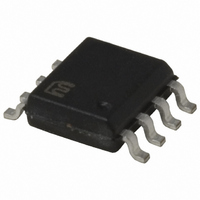MIC5013BM Micrel Inc, MIC5013BM Datasheet - Page 11

MIC5013BM
Manufacturer Part Number
MIC5013BM
Description
IC DRIVER MOSF HI/LO SIDE 8SOIC
Manufacturer
Micrel Inc
Datasheet
1.MIC5013YM.pdf
(15 pages)
Specifications of MIC5013BM
Configuration
High or Low Side
Input Type
Non-Inverting
Delay Time
60µs
Number Of Configurations
1
Number Of Outputs
1
Voltage - Supply
7 V ~ 32 V
Operating Temperature
-40°C ~ 85°C
Mounting Type
Surface Mount
Package / Case
8-SOIC (3.9mm Width)
Number Of Drivers
1
Driver Type
High Side/Low Side
Operating Supply Voltage (max)
32V
Power Dissipation
1.25W
Operating Supply Voltage (min)
7V
Operating Supply Voltage (typ)
15V
Turn Off Delay Time
4us
Turn On Delay Time (max)
60us
Operating Temp Range
-40C to 85C
Operating Temperature Classification
Industrial
Mounting
Surface Mount
Pin Count
8
Package Type
SOIC
Lead Free Status / RoHS Status
Contains lead / RoHS non-compliant
Current - Peak
-
High Side Voltage - Max (bootstrap)
-
Lead Free Status / Rohs Status
Not Compliant
Available stocks
Company
Part Number
Manufacturer
Quantity
Price
Part Number:
MIC5013BM
Manufacturer:
MICREL
Quantity:
20 000
Company:
Part Number:
MIC5013BM/YM
Manufacturer:
MICREL
Quantity:
300
MIC5013
Applications Information
Since the supply current in the “OFF” state is only a small
leakage, the 100nF bypass capacitor tends to remain
charged for several seconds after the MIC5013 is turned
off. In a PWM application the chip supply is actually much
higher than the system supply, which improves switching
time.
Electronic Circuit Breaker (Figure 7). The MIC5013 forms
the basis of a high-performance, fast-acting circuit breaker.
By adding feedback from FAULT to INPUT the breaker can
be made to automatically reset. If an over-current condition
occurs, the circuit breaker shuts off. The breaker tests the
load every 18ms until the short is removed, at which time
the circuit latches ON. No reset button is necessary.
Opto-Isolated Interface (Figure 8). Although the MIC5013
has no special input slew rate requirement, the lethargic
transitions provided by an opto-isolator may cause oscil-
lations on the rise and fall of the output. The circuit shown
accelerates the input transitions from a 4N35 opto-isolator
by adding hysteresis. Opto-isolators are used where the
control circuitry cannot share a common ground with the
MIC5013 and high-current power supply, or where the
control circuitry is located remotely. This implementation is
intrinsically safe; if the control line is severed the MIC5013
will turn OFF.
Fault-Protected Industrial Switch (Figure 9). The most
common manual control for industrial loads is a push but-
ton on/off switch. The “on” button is physically arranged in
a recess so that in a panic situation the “off” button, which
extends out from the control box, is more easily pressed.
This circuit is compatible with control boxes such as the
CR2943 series (GE). The circuit is configured so that if
both switches close simultaneously, the “off” button has
precedence. If there is a fault condition the circuit will latch
off, and it can be reset by pushing the “ON” button.
July 2005
15Vp-p, 20kHz
Squarewave
100nF
200V
10mA
Control Input
15V
1N4003 (2)
1N4003
100kΩ
4N35
(Continued)
33pF
100kΩ
1kΩ
Figure 10. High-Voltage
MPSA05
Bootstrapped Driver
33kΩ
6.2kΩ
11
This application also illustrates how two (or more) MOS-
FETs can be paralleled. This reduces the switch drop, and
distributes the switch dissipation into multiple packages.
High-Voltage Bootstrap (Figure 10). Although the MIC5013
is limited to operation on 7 to 32V supplies, a floating boot-
strap arrangement can be used to build a high-side switch
that operates on much higher voltages. The MIC5013 and
MOSFET are configured as a low-side driver, but the load is
connected in series with ground. The high speed normally
associated with low-side drivers is retained in this circuit.
Power for the MIC5013 is supplied by a charge pump. A
20kHz square wave (15Vp-p) drives the pump capacitor
and delivers current to a 100µF storage capacitor. A zener
diode limits the supply to 18V. When the MIC5013 is off,
power is supplied by a diode connected to a 15V supply. The
circuit of Figure 8 is put to good use as a barrier between
low voltage control circuitry and the 90V motor supply.
Half-Bridge Motor Driver (Figure 11). Closed loop control
of motor speed requires a half-bridge driver. This topology
presents an extra challenge since the two output devices
should not cross conduct (shoot-through) when switching.
Cross conduction increases output device power dissipation
and, in the case of the MIC5013, could trip the over-current
comparator. Speed is also important, since PWM control
requires the outputs to switch in the 2 to 20kHz range.
The circuit of Figure 11 utilizes fast configurations for both
the top- and bottom-side drivers. Delay networks at each
input provide a 2 to 3µs dead time effectively eliminating
cross conduction. Both the top- and bottom-side drivers
are protected, so the output can be shorted to either rail
without damage.
1
2
3
4
Thresh
Source
Input
Sense
MIC5013
Fault
Gate
Gnd
V+
8
7
6
5
5BPB56HAA100
1N4746
1/4 HP, 90V
100µF
+
( GE )
M
90V
IRFP250
10mΩ
KC1000-4T
(Kelvin)
MIC5013
Micrel, Inc.







